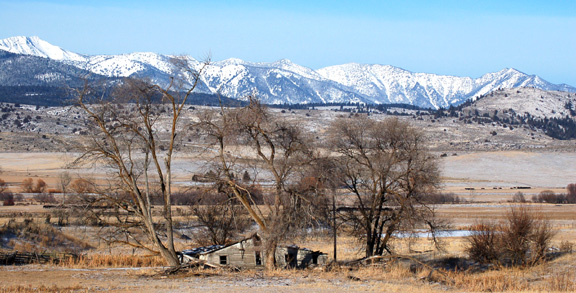In this Edition:
- The Nez Perce: A Sometimes Un-recognized Piece of Wallowa County History
- Wolf News
- Wild Bison Herd in Wallowa County
- "Inside Job"--Another "must see" documentary
- Quote on war from an American living in Norway
- Nuclear Nightmare_____
The Nez Perce: A Sometimes Un-recognized Piece of Wallowa County HistoryMy best friend was going through her files today and discovered a bit of history from Wallowa County. It was an old 1985 brochure from the Forest Service titled "Nee-Me-Poo National Recreational Trail."
This from the portion under the heading of "History:"
The Nez Perce Treaty of 1855 reserved vast areas of land for the Nez Perce Indian Tribe. The land stretched from what is now central Idaho to the eastern edges of both Washington and Oregon. Tucked remotely away in the Oregon allotment was the beautiful and fertile Wallowa Valley. Here, among the picturesque setting and the superior hunting grounds, Chief Tu-eka-kas (Chief Joseph's father) and his band of Nez Perce lived peacefully. For unnumbered generations the Wallowa Valley had been the home of their ancestors.
Hostilities began when settlers and cattlemen increasingly trespassed upon the Indian's land. In 1861, when gold was discovered in Orofino, Idaho, 10,000 miners invaded their home land in search of the precious mineral. The friendly Indians became restless.
In 1863, the U.S. Government offered a new treaty in an attempt to pacify the new settlers and give unobstructed access to the newly discovered mines, Chief Tu-eka-kas refused to sign the treaty because it totally excluded the Wallowa Valley and outlying areas from the Indian's land. However, a number of Chiefs whose interests were not affected, signed the new treaty and the Government contended that all the Nez Perce were bound. Tu-eka-kas and his tribe were to leave the Wallowa Valley and move to the newly designated Lapwai reservation In Idaho.
Tu-eka-kas Ignored the treaty, and despite grievances against the Government, skillfully maintained peace with the settlers. He and his people remained in the Wallowa Valley until his death.
With Tu-eka-kas now in his grave, the mantle of authority fell upon Joseph. His young braves were held in check in spite of the growing resentment felt at losing more land and horses to an increasing white population. The Government continued to urge Joseph to give up the land peacefully and move his people to the reservation.
Finally, in the spring of1877, General Howard of the United States Army became impatient and notified Chief Joseph that he must move within 30 days or be driven out by soldiers. Joseph, realizing the unfavorable odds of a fight With the U.S. Army, reluctantly agreed to move. The disappointed tribe dismantled their Wallowa Valley camp for the last time in late May of 1877, moving off toward the Snake River.
Chief Josephs band consisted of approximately 400 indians, including about 64 braves, ages 16 and over. They took over 1,000 head of horses and cattle, leaving much of their stock behind. The Nee-Me-Poo National Recreation Trail was the route followed to the Snake River.
After crossing the Snake River, Joseph's people joined with other bands of Nez Perce and a small group of Palouses. Thereafter, the historical Nez Perce War began, turning the peaceful journey into a flight for freedom and sanctuary in Canada.
Every mile of the retreat brought danger. Aided by Chlef Joseph's surpassing military genius, the Nez Perce confused and outwitted the 2,000 regular troops of the United States Army. Though the warriors were encumbered with women, children and the elderly throughout their flight, they were able to outdistance the fresh troops continually appearing in their path.
Joseph and his people came to the end of their bloody trail in the Bear Paw Mountains of Montana, only 30 miles from the Canadian refuge. Hemmed in by winter snow the Indians were besieged by the U.S. Army and forced to surrender. After three months of unquestionable grief, anxiety and hardship, Joseph, in a pathetic, yet dramatic surrender, said: "From where the sun now shines, I shall fight no more forever."
Wikipedia account:
Nez Perce WarAnd:
The Nez Perce (Nee-Me-Poo) National Historic Trail (print brochure)
_____
Wolf NewsInterior Announces Proposed Settlement of Gray Wolf LawsuitTerms of Proposed Agreement: Endangered Species Act (ESA) Protections for Gray Wolves in the Northern Rocky Mountains__
Western Watersheds Project Doesn't agree (via email report)Western Watersheds Project Continues to Fight For Wolves In The Northern Rocky Mountains
. . . .
As political pressure grows to delist wolves in the Northern Rocky Mountains
Western Watersheds Project stands up to the pressure.
Several of WWP's co-plaintiffs in litigation that successfully re-instated Endangered Species Act protections for wolves in August 2010 have agreed to a settlement with the U.S. Fish and Wildlife Service and are asking the federal court for Montana to partially vacate that decision and delist wolves in Idaho and Montana from protections of the Endangered Species Act.
. . . .
Western Watersheds Project along with our co-plaintiffs the Alliance for the Wild Rockies and Friends of the Clearwater oppose the proposed settlement and will ask the federal court to deny the request to partially vacate its August 2010 decision and delist wolves in Idaho and Montana.
Western Watersheds Project does not support the settlement for the following reasons:
- The settlement will result in wolves being killed in Idaho and Montana beyond their ability to recover a viable population.
- Western Watersheds Project supports the laws of the United States. The proposed settlement asks a federal judge to authorize the breaking of federal law.
- The proposed settlement includes no requirements to protect any specific minimum number of wolves in Idaho and Montana.
- Western Watersheds Project does not believe that this proposed settlement will prevent or dissuade Congress from taking legislative action to delist wolves.
Western Watersheds Project is committed by science and law to the protection of wolves across the United States.
Please Support Western Watersheds Project
__
• Defenders of Wildlife
Settlement reached on wolf recovery in Idaho and MontanaWolves to remain protected in Oregon and Washington
__
Q&A--Settlement of Litigation over Endangered Species Act Protections for Northern Rocky Mountain Gray Wolves8. Who are the Settling Plaintiffs?
Defenders of Wildlife
Natural Resources Defense Council
Sierra Club
Center for Biological Diversity
Hells Canyon Preservation Council
Greater Yellowstone Coalition
Jackson Hole Conservation Alliance
Oregon Wild
Cascadia Wildlands Project
Wildlands Network (formerly the Wildlands Project)
9. Who are the non-Settling Plaintiffs?
Alliance for the Wild Rockies
Humane Society of the United States
Friends of the Clearwater
Western Watersheds Project
__
No comment right now on death of female wolf that could have expanded wolf numbers:Oregon Department of Fish and Wildlife
Contact: Michelle Dennehy (503) 947-6022, (503) 931-2748 Michelle.N.Dennehy@state.or.us
Internet: www.dfw.state.or.us Fax: (541) 947-6009
For Immediate Release March 16, 2011
Cause of Imnaha wolf’s death unclearLA GRANDE, Ore.—The exact cause of death for the Imnaha wolf found dead in early March is unclear.
Washington Animal Disease Diagnostic Laboratory ran several tests on the carcass looking for injuries, disease and toxins but test results did not point to a specific cause of death.
The only abnormal finding was some internal hemorrhage in the wolf’s chest cavity. Forensic analysis did not point to a clear cause of the hemorrhage but biologists believe the hemorrhage may have contributed to the wolf’s death.
While the cause of the wolf’s death is unclear, wildlife managers acknowledge that capture-related deaths of wildlife can happen.
Wildlife managers take several steps to reduce the risk of injury during capture efforts, including blindfolding the animal (to protect eyes and reduce stress), cooling or warming the animal as needed, providing sedatives when necessary, and having a veterinarian on site.
All the above steps were taken with this wolf. According to the veterinarian and wildlife biologists at the capture site, no problems were observed when the wolf was released. Radio tracking data indicated that the wolf recovered and traveled at least five miles after the collaring.
_____
Wild Bison Herd in Wallowa CountyWild herd of bison roams base of Wallowa Mountains in OregonPublished: Saturday, March 19, 2011, 1:00 PM Updated: Saturday, March 19, 2011, 7:20 PM
By Richard Cockle, The Oregonian
Before the white settlement era, bison shared eastern Oregon with deer, elk, bears and wolves. Nevertheless, they aren't wildlife under Oregon law. And while their meat is prominent in supermarkets and restaurant menus, they aren't livestock, either.
They are private property and considered domestic animals -- similar to peacocks and llamas, said Rodger Huffman, spokesman for the Oregon Department of Agriculture's Animal Health and Identification Division.
Bison found grazing on private or public lands without grazing rights are trespassing, Huffman said. That makes for a thorny issue in this case because the herd has no owner.
_____
"Inside Job"--Another "must see" documentaryWatched "Inside Job" last night--very impressive and even more important documentary--which may have something to do with it winning the Academy Award for
Best Documentary Feature (not that I would normally pay any attention to the Academy Awards, but sometimes they do the right thing.)
You can get "Inside Job" at Redbox and probably Blockbuster box outlets in Baker City for a buck, or order it on NetFlix.
Here is an interesting review from
Inside Job-Amazon.
217 of 224 people found the following review helpful:
5.0 out of 5 stars
A must-see movie, October 19, 2010
By Domenico Rosa -
This priceless documentary presents a devastating expose of the staggering Wall Street swindle that caused the economic meltdown of 2008. The interview with Martin Feldstein brought back to mind the hoopla of his appointment as chief economic adviser to President Reagan. The movie points out that Feldstein initiated the financial deregulation follies that led to the looting of the Savings and Loans and culminated with the passage of the Commodity Futures Modernization Act of 2000, the lead sponsor of which was Senator Phil Gramm. It was truly depressing to see how this massive swindle was pulled off through the collusion of the economic advisers, politicians, high-flown professors of economics with scandalous and highly unethical conflicts-of-interest, investment banks, and ratings agencies. At the end of "Inside Job," Robert Gnaizda lists various groups that should be prosecuted. When asked why this has not been done, he answered: "It's a Wall Street government!"
Some of the topics in the movie were covered in the FRONTLINE broadcast "Inside the Meltdown" and in the FRONTLINE broadcast "The Warning." The latter exposed how Brookley Born was sabotaged by Alan Greenspan, Robert Rubin and Larry Summers--the Troika that is directly responsible for the massive fraud perpetrated by the Wall Street crowd.
It is reassuring to see that some members of Congress were competent. Senator Byron Dorgan (D. North Dakota) voted against his own party, predicting that the repeal of Glass-Steagall would lead to massive taxpayer bailouts. On 19 September 2009, Senator Dorgan was interviewed by Scott Simon on "Weekend Edition Saturday." The following is from the transcript at:
Sen. DORGAN: Well, I mean, it does precious little to say I told you so, but this was 10 years ago on the floor of the U.S. Senate. At the time, I said I thought it was a huge mistake and, you know, I was critical of the Clinton administration and critical of the Republicans in Congress who were pushing it.
But what I said is I think within a decade we're going to see massive taxpayer bailouts. I didn't necessarily know that for sure but it turns out my prognostication was a pretty expensive lesson. Because it made no sense that we should repeal Glass-Steagall and the protections that were put in place after the Great Depression.
And the result of that, in my judgment, was to steer this economy into the ditch and cause a significant economic wreck that's going to take us some time to get out of.
SIMON: The timing is something that intrigues me, 'cause you said this in 1999, whereas you note your party was in party.
Sen. DORGAN: Uh-huh. Well, but let me just say to you that the legislation that was passed by the Congress was called Gramm-Leach-Bliley--all three Republicans. Phil Gramm--those three Republicans led the approach. It was Republican legislation but warmly embraced by President Clinton, Secretary of Treasury Rubin and so on.
But I was one of eight U.S. senators that went to the floor of the Senate repeatedly in opposition to what they were doing. And, you know, as I said, I made some prognostications and say if we do this we're going to see massive taxpayer bailouts in the future.
And unfortunately, that has been the case.
"Inside Job" goes much deeper in exposing the extensive unethical conduct and shameless conflicts-of-interest of so many professors of economics, especially Frederic Mishkin, a governor at the Federal Reserve until August 2008 and now at Columbia University. According to the movie, he co-authored a fraudulent paper "The Stability of Icelandic Banks," without divulging that he had been paid $124,000 by the Iceland Chamber of Commerce to write it. In his current list of publications, he has changed the title to "The Instability ..." John Campbell, the chairman of Harvard's department of economics is left speechless--with a bewildered facial expression--when he is asked about the conflicts-of-interest of his department members.
How can anyone believe anything that is published by economists?
__
Quote from an American living in Norway:"The disparity between what we are told or what we believe about war and war itself is so vast that those who come back are often rendered speechless. What do you say to those who advocate war as an instrument to liberate the women of Afghanistan or bring democracy to Iraq? How do you tell them what war is like? How do you explain that the very proposition of war as an instrument of virtue is absurd? How do you cope with memories of children bleeding to death with bits of iron fragments peppered throughout their small bodies? How do you speak of war without tears?"
From The Photographer by Emmanuel Guibert
__
From
Jay Hanson (& Ralph Nader):
Nuclear NightmareThe unfolding multiple nuclear reactor catastrophe in Japan is prompting overdue attention to the 104 nuclear plants in the United States—many of them aging, many of them near earthquake faults, some on the west coast exposed to potential tsunamis.
Nuclear power plants boil water to produce steam to turn turbines that generate electricity. Nuclear power’s overly complex fuel cycle begins with uranium mines and ends with deadly radioactive wastes for which there still are no permanent storage facilities to contain them for tens of thousands of years.
Atomic power plants generate 20 percent of the nation’s electricity. Over forty years ago, the industry’s promoter and regulator, the Atomic Energy Commission estimated that a full nuclear meltdown could contaminate an area “the size of Pennsylvania” and cause massive casualties. You, the taxpayers, have heavily subsidized nuclear power research, development, and promotion from day one with tens of billions of dollars.
Because of many costs, perils, close calls at various reactors, and the partial meltdown at the Three Mile Island plant in Pennsylvania in 1979, there has not been a nuclear power plant built in the United States since 1974.
Now the industry is coming back “on your back” claiming it will help reduce global warming from fossil fuel emitted greenhouse gases.
Pushed aggressively by President Obama and Energy Secretary Chu, who refuses to meet with longtime nuclear industry critics, here is what “on your back” means:
1. Wall Street will not finance new nuclear plants without a 100% taxpayer loan guarantee. Too risky. That’s a lot of guarantee given that new nukes cost $12 billion each, assuming no mishaps. Obama and the Congress are OK with that arrangement.
2. Nuclear power is uninsurable in the private insurance market—too risky. Under the Price-Anderson Act, taxpayers pay the greatest cost of a meltdown’s devastation.
3. Nuclear power plants and transports of radioactive wastes are a national security nightmare for the Department of Homeland Security. Imagine the target that thousands of vulnerable spent fuel rods present for sabotage.
4. Guess who pays for whatever final waste repositories are licensed? You the taxpayer and your descendants as far as your gene line persists. Huge decommissioning costs, at the end of a nuclear plant’s existence come from the ratepayers’ pockets.
5. Nuclear plant disasters present impossible evacuation burdens for those living anywhere near a plant, especially if time is short.
Imagine evacuating the long-troubled Indian Point plants 26 miles north of New York City. Workers in that region have a hard enough time evacuating their places of employment during 5 pm rush hour. That’s one reason Secretary of State Clinton (in her time as Senator of New York) and Governor Andrew Cuomo called for the shutdown of Indian Point.
6. Nuclear power is both uneconomical and unnecessary. It can’t compete against energy conservation, including cogeneration, windpower and ever more efficient, quicker, safer, renewable forms of providing electricity. Amory Lovins argues this point convincingly (see RMI.org). Physicist Lovins asserts that nuclear power “will reduce and retard climate protection.” His reasoning: shifting the tens of billions invested in nuclear power to efficiency and renewables reduce far more carbon per dollar (
WHY A FUTURE FOR THE NUCLEAR INDUSTRY IS RISKY). The country should move deliberately to shutdown nuclear plants, starting with the aging and seismically threatened reactors. Peter Bradford, a former Nuclear Regulatory Commission (NRC) commissioner has also made a compelling case against nuclear power on economic and safety grounds ((
WHY A FUTURE FOR THE NUCLEAR INDUSTRY IS RISKY)).
There is far more for ratepayers, taxpayers and families near nuclear plants to find out. Here’s how you can start:
1. Demand public hearings in your communities where there is a nuke, sponsored either by your member of Congress or the NRC, to put the facts, risks and evacuation plans on the table. Insist that the critics as well as the proponents testify and cross-examine each other in front of you and the media.
2. If you call yourself conservative, ask why nuclear power requires such huge amounts of your tax dollars and guarantees and can’t buy adequate private insurance. If you have a small business that can’t buy insurance because what you do is too risky, you don’t stay in business.
3. If you are an environmentalist, ask why nuclear power isn’t required to meet a cost-efficient market test against investments in energy conservation and renewables.
4. If you understand traffic congestion, ask for an actual real life evacuation drill for those living and working 10 miles around the plant (some scientists think it should be at least 25 miles) and watch the hemming and hawing from proponents of nuclear power.
The people in northern Japan may lose their land, homes, relatives, and friends as a result of a dangerous technology designed simply to boil water. There are better ways to generate steam.
Like the troubled Japanese nuclear plants, the Indian Point plants and the four plants at San Onofre and Diablo Canyon in southern California rest near earthquake faults. The seismologists concur that there is a 94% chance of a big earthquake in California within the next thirty years. Obama, Chu and the powerful nuke industry must not be allowed to force the American people to play Russian Roulette!













